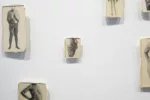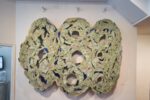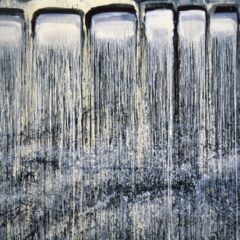
Doug (in stripes) and Mike Starn at The Print Center before the opening, with Executive Director Elizabeth Spungen behind.
Doug and Mike Starn (they are identical twins) grew up in Absecon, N.J. But their art career is pure New York, and they have never shown here in Philadelphia. They are at The Print Center with an exhibit called Black Pulse 2000-2007: Doug + Mike Starn.
I stopped by the day the exhibit opened, and got to ask Doug Starn lots of questions.
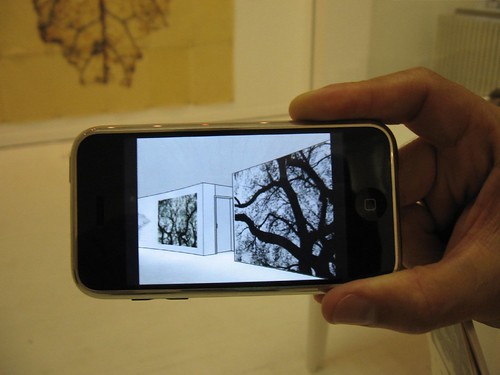
The plan for the South Ferry Station installation.
The high point was his video iPod with touch technology. He pulled it out to show me the plan for what the twins are doing for Arts for Transit. They were commissioned to contribute art at the newly redone South Ferry Station in New York. I loved taking the nano-scaled virtual walk through the site. There will be a large grille or gate that’s a laser-cut stainless steel silhouette of leaves and branches. The lacy, bright metal looks like it will be a wow! The installation will also include glass with layers of images in it, and mosaics. So, sorry for the digression from the exhibit at The Print Center, but really, that was what interested me most–both for the techno-wizardry and for the plan.
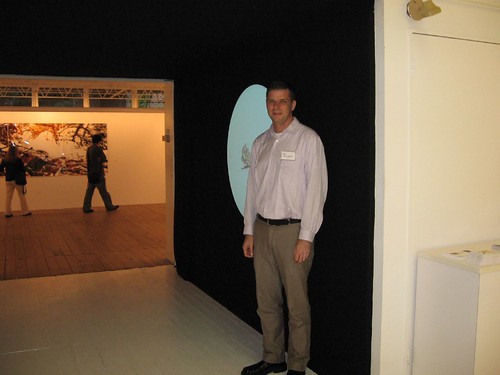
John Caperton, The Print Center’s new curator, standing in front of the projection area.
My second favorite thing was the way a video was installed, projected on a circle (screen goo on plywood) surrounded by black felt. The luminous projection was a punctuation point against the light-absorbing black-hole fabric. It turned the hallway at the top of the stairs into a space of its own–the suggestion of a black box space. The video was of blowing leaves catching the light.

Doug and Mike Starn, Black Pulse 17 (lambda), Digital C-Print, 287 x 119 inches, 2 of 2; the luminescence of this print does not come through here.
Besides the video, the show of mostly photography-based work included an enormous leaf on several sheets of shiny photographic paper and leaves on tea-brown gampi paper. Many of the gampi-paper leaf portraits were also made of multiple sheets pinned to the wall. Although the labels said the work had Scotch Tape, I didn’t see any. All I saw were pins. But Scotch Tape is a Starn signature, so I suppose it was there–disappearing Scotch Magic Tape, sort of like evanescent leaves?
I asked why the ultra-white, glossy paper for some images, the darker gampi paper for others. Starn said he and his brother like the glossy, clinical-looking Fujiflex because it has incredible light within it–it was a way to show off the light in the leaves.
“Light for us is what controls us. Light is what we love,” he said. “Leaves are light made physical. …They take the carbon from our breath and build their bodies with it.” What’s magic, he said, is that carbon is a black body, something that emits as much as it absorbs.
The clinical look, however, undermines the transcendence and the alchemy.

Doug and Mike Starn, Black Pulse 3, Inkjet prints with albumen, encaustic, scotch tape & glue on Gampi, 14 x 11, Artists Proof 1, 154 x 112 inches, 1 of 1
The works on gampi paper–ink-jet prints with encaustic–are more like memento mori prints, Doug said (I didn’t talk to Mike at all; he was busy talking to other people).
The way the pair came to Philadelphia has to do with Katherine Ware, the curator of photographs at the Philadelphia Museum of Art. Does said she emailed the Print Center’s excecutive director, Elizabeth Spungen, suggesting the artists and the gallery were a good match.
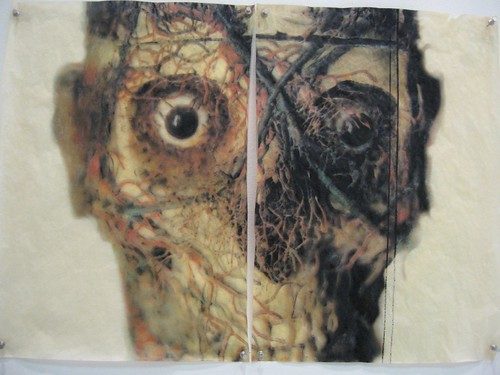
Most of the work seemed precious to me; and the vitrine with a pile of leaves inside seemed silly. But one photographic print, not of a leaf, but of a skull with a network of strangely placed veins over it and glass eyes was interesting, although ghoulish. Doug said the twins were invited to Napoli to take photographs of these skeletons, one a man, one a woman, in the cellar of Romando di Sangro, a 19th century prince, alchemist, connoisseur and printmaker. “In the baseement, there were these two creatures. …They’re freaky.” They seem to be a mix of the real and sculpture. The image was altered in the computer, to add some color to the “veins.”
I’d say this is the reason to see the show, which is up to Nov. 21.


